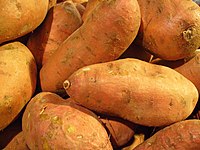
Photo from wikipedia
Soil waterlogging occurs when excess water saturates the soil pores with either no layer of water or a very fine one on the soil surface. Since gas diffusion in water… Click to show full abstract
Soil waterlogging occurs when excess water saturates the soil pores with either no layer of water or a very fine one on the soil surface. Since gas diffusion in water is several folds slower than in air, the oxygen concentration decreases rapidly in waterlogged soils, thereby triggering a cascade of conditions that are detrimental to the growth of most plant species (Colmer and Greenway, 2011). Flooding is the primary cause of yield losses in Asia and Latin America while, worldwide, between 10 and 16% of the arable soils are estimated to be affected by waterlogging (Yaduvanshi et al., 2014; FAO, 2015). Moreover, the frequency and intensity of flooding events is expected to increase in all world regions in consequence of climate change (Westra et al., 2014; IPCC, 2018). Thus, the purpose of the research topic “Crop Response to Waterlogging” is to gather knowledge from different geographic regions and research fields in order to help the scientific and social community to elaborate an integrated approach to face its adverse effects. The articles published in this research topic deal with a wide range of crop species, including cereals (Arduini et al.; Panozzo et al.; Yamauchi et al.), forage and grain legumes (Pucciariello et al.; Zhang et al.), and tree crops (Ruperti et al.; Iacona et al.), thus demonstrating the widespread interest in plant sciences for this soils condition. The researches published in this e-book describe different investigation approaches and propose alternative solutions, which range from the reduction of waterlogging risk by improving agronomic and engineering solutions (Manik et al.; Zhang et al.), to the better understanding of crop response to waterlogging (Arduini et al.; Ejiri and Shiono; Lin and Sauter; Pucciariello et al.; Ruperti et al.; Yamauchi et al.), and the selection of crops and genotypes that are more tolerant to waterlogging conditions (Iacona et al.; Panozzo et al.; Pompeiano et al.). Waterlogging generally induces changes in gene expressions, which result in physiological and morphological changes in plants. Flooding responses on grapevine are reviewed by Ruperti et al., and their findings enable us to draft a first comprehensive view of the metabolic pathways involved in grapevine’s root responses and to highlight a transcriptional and metabolic reprograming during and after exposure to waterlogging. The gene expressions of AOX1A, CYP81D8, and putative PFP genes were analyzed in a large set of commercial maize hybrids under extreme waterlogging conditions and their involvement in the morphological changes are discussed (Panozzo et al.). Roots are the first target of waterlogging stress in plants, and it is well documented that aerenchyma formation plays a crucial role in internal long-distance oxygen transport from shoot to root under waterlogged soil. A comparison of the cross-sectional area of root tissues among three crop species (wheat, maize, and rice), subjected to aerated or deoxygenated conditions, revealed that
Journal Title: Frontiers in Plant Science
Year Published: 2019
Link to full text (if available)
Share on Social Media: Sign Up to like & get
recommendations!